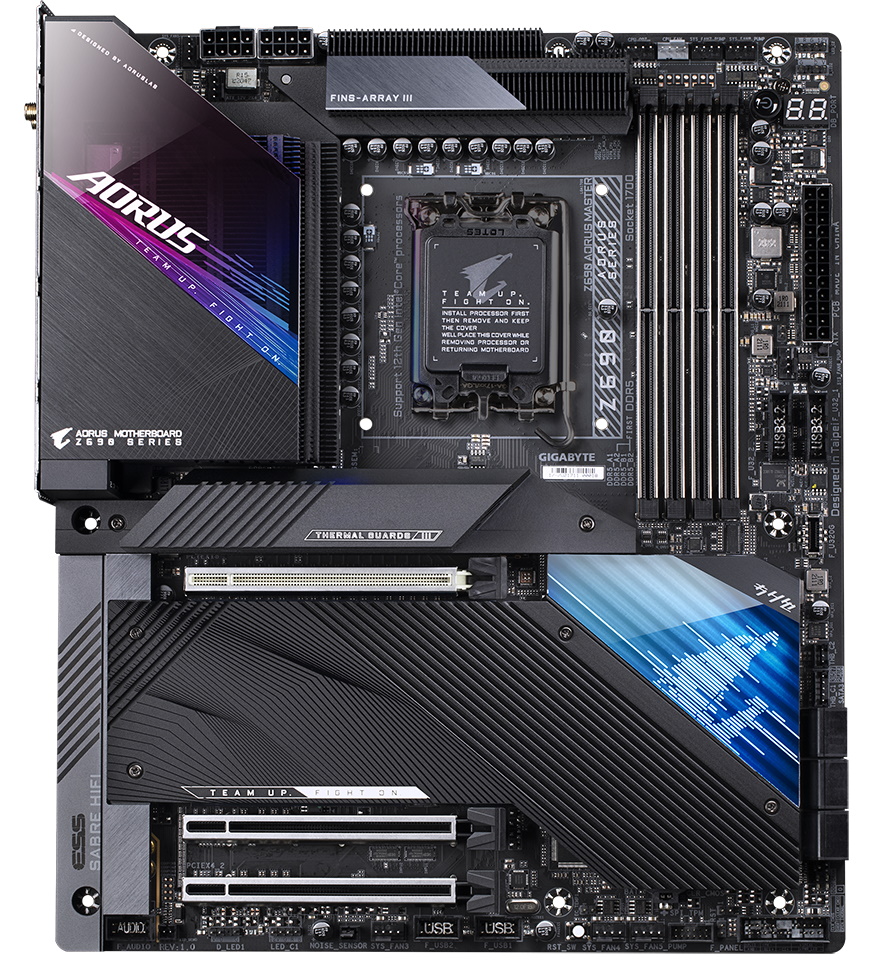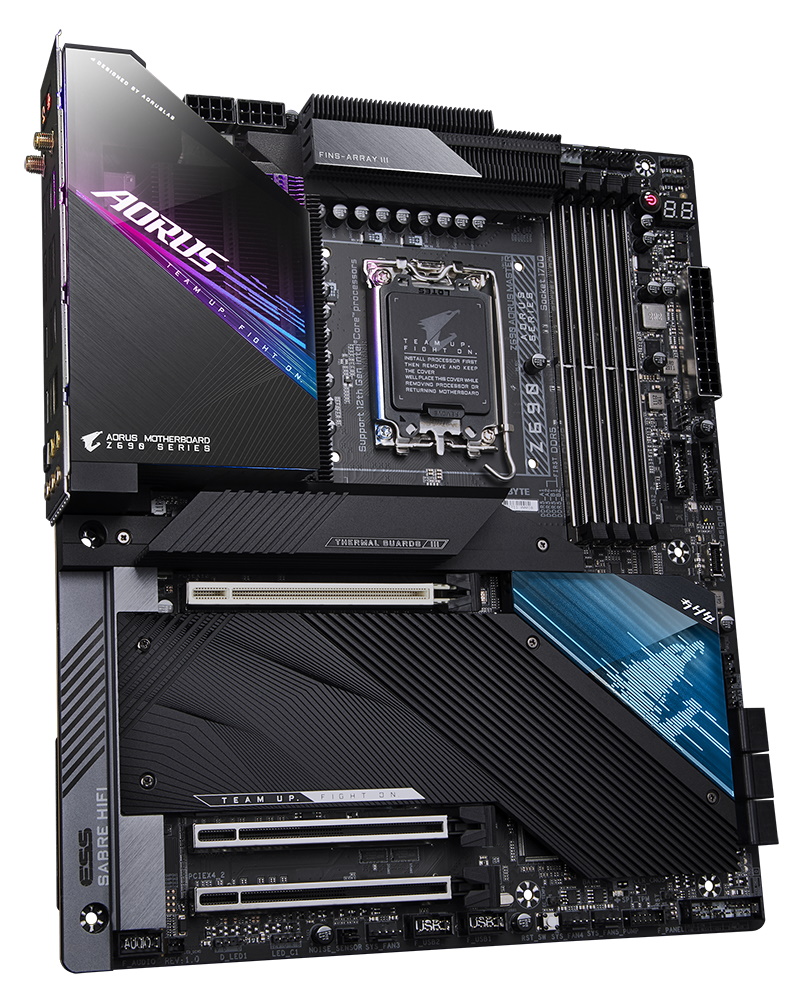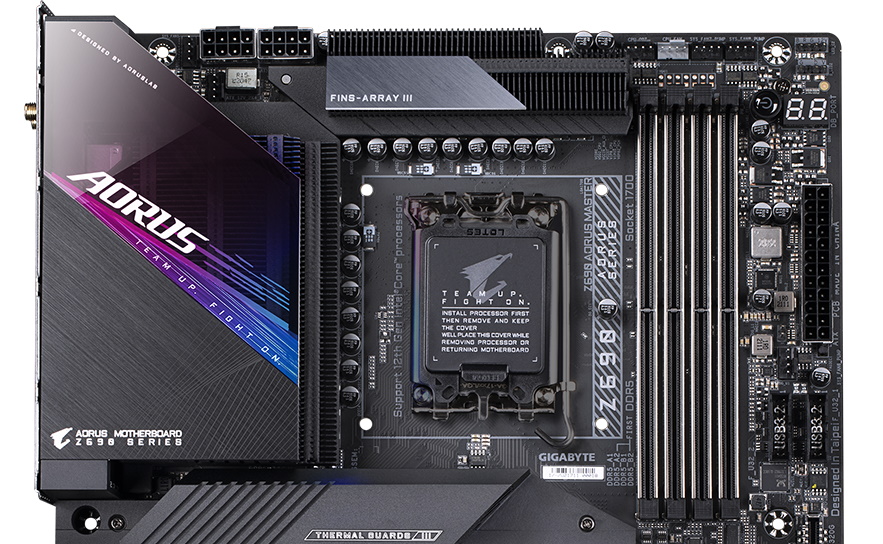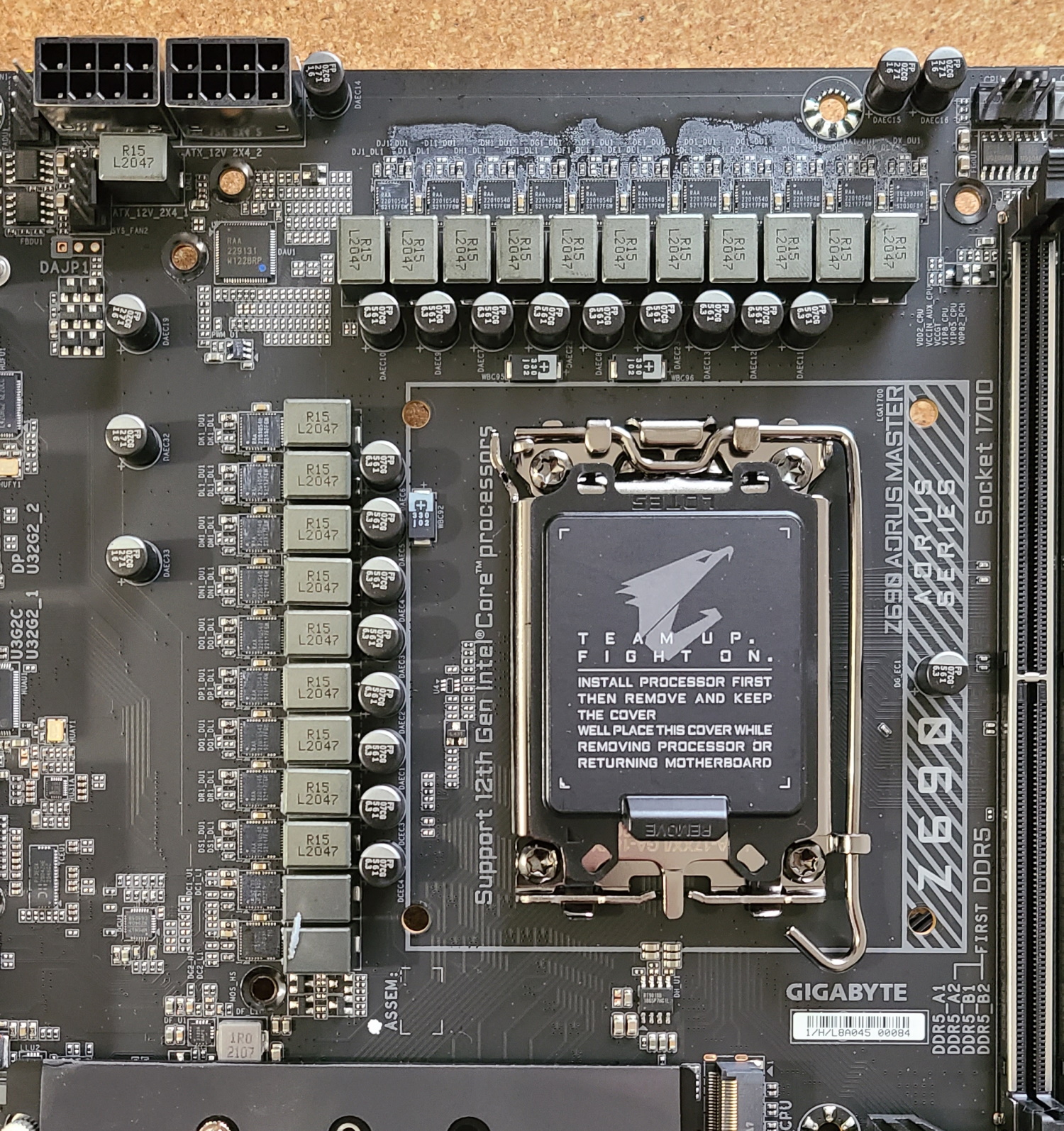Tom's Hardware Verdict
The Gigabyte Z690 Aorus Master sits in the upper mid-range of overclockable Alder Lake boards at $469.99. While far from cheap, it comes with five M.2 sockets, 10 GbE and integrated Wi-Fi 6E, overbuilt VRMs, and an updated premium appearance.
Pros
- +
+ Overbuilt 105A power delivery
- +
+ Five M.2 sockets
- +
+ 11 total rear USB ports
Cons
- -
Last-gen audio codec
Why you can trust Tom's Hardware
The Gigabyte Z690 Aorus Master hits our test bench with a statement from Gigabyte calling it “the new king of gaming.” Along with the title, the new Aorus Master gets an updated features list and includes one of the most capable VRMs, all from a $469.99 (MSRP) motherboard. The Z690 Master boasts a whopping five M.2 sockets, 10 GbE and Wi-Fi 6E, along with an updated appearance. This mid-range board not only has the look to be an excellent base for your new Alder Lake build, but the hardware to support it too.
If we look at the last generation Z590 Aorus Master, Gigabyte stuck with the black and orange theme we’re familiar with over the past few years. The new board gets away from that, rocking a more generic yet still premium appearance. Outside of looks, one of the most significant differences between the last generation and this board is the M.2 socket count (up from three) and power delivery (quantity and quality increases). Overall, this is a multi-faceted improvement form the previous gen. And although the $469.99 price tag is steep for what many would consider a mid-range or upper mid-range board, it’s reasonable compared to the existing market and similarly priced Z690 options.
Our Aorus Master did well overall on the performance front, with most benchmarks running average or slightly faster than average. Gaming performance was solid overall, but if it’s crowning this board as king, that’s compared to the last-generation Master. Compared to other Z690 boards, the only tests where it was slower than average was in the Procyon office suite. That said, the difference wasn’t big in this line of testing, but it did compare more closely to the DDR4 boards than the DDR5 options we’ve tested. Outside of that, it’s just as or slightly better performing than its peers.
Read on for much more, including overclocking adventures, features, and all details that may distinguish this board from the rest. Before we start though, here’s a complete list of the Gigabyte Z690 Aorus Master specifications from the Gigabyte website.
Specifications - Gigabyte Z690 Aorus Master
| Socket | LGA 1700 |
| Chipset | Z690 |
| Form Factor | E-ATX |
| Voltage Regulator | 22 Phase (19+1+2, 105A MOSFETs for Vcore) |
| Video Ports | (1) DisplayPort (v1.2) |
| USB Ports | (1) USB 3.2 Gen 2x2 Type-C port (20 Gbps) |
| Row 6 - Cell 0 | (1) USB 3.2 Gen 2 Type-C port (10 Gbps) |
| Row 7 - Cell 0 | (5) USB 3.2 Gen 2 (10 Gbps) |
| Row 8 - Cell 0 | (4) USB 3.2 Gen 1 (5 Gbps) |
| Network Jacks | (1) 10 GbE |
| Audio Jacks | (2) Analog + SPDIF |
| Legacy Ports/Jacks | ✗ |
| PCIe x16 | (1) v. 5.0 (x16) |
| Row 13 - Cell 0 | (2) v. 3.0 (x4) |
| PCIe x8 | ✗ |
| PCIe x4 | ✗ |
| PCIe x1 | ✗ |
| CrossFire/SLI | AMD Quad-GPU CrossFire and 2-Way Crossfire |
| DIMM slots | (4) DDR4 6400+(OC), 128GB Capacity |
| M.2 slots | (1) PCIe 4.0 x4 (64 Gbps) / PCIe (up to 110mm) |
| Row 20 - Cell 0 | (2) PCIe 4.0 x4 (64 Gbps) / PCIe (up to 110mm) |
| Row 21 - Cell 0 | (1) PCIe 3.0 x4 (32 Gbps) / PCIe (up to 80mm) |
| Row 22 - Cell 0 | (1) PCIe 4.0 x4 (64 Gbps) / PCIe + SATA (up to 80mm) |
| U.2 Ports | ✗ |
| SATA Ports | (6) SATA3 6 Gbps (Supports RAID 0/1/5/10) |
| USB Headers | (1) USB v3.2 Gen 2x2, Type-C (20 Gbps) |
| Row 26 - Cell 0 | (2) USB v3.2 Gen 1 (5 Gbps) |
| Row 27 - Cell 0 | (2) USB v2.0 (480 Mbps) |
| Fan/Pump Headers | (10) 4-Pin (CPU, Water cooling CPU, System, System/Pump fans) |
| RGB Headers | (2) aRGB Gen2 (3-pin) |
| Row 30 - Cell 0 | (2) RGB (4-pin) |
| Diagnostics Panel | 2-character debug LED |
| Internal Button/Switch | Reset button |
| SATA Controllers | ✗ |
| Ethernet Controller(s) | Marvell AQtion AQC113C (10 Gbps) |
| Wi-Fi / Bluetooth | Intel AX210 Wi-Fi 6E (2x2 ax, MU-MIMO, 2.4/5/6 GHz, 160 MHz, BT 5.2) |
| USB Controllers | Realtek RTS5411 (2) |
| HD Audio Codec | Realtek ALC1220 |
| DDL/DTS Ultra | ✗ / Yes |
| Warranty | 3 Years |
After opening the box and taking the board out, you’ll find the accessory stack hidden under a cardboard partition. The Aorus Master includes all of the basics and more. Below is a list of everything included with this board.
- (6) SATA 6Gb/s cables
- Wi-Fi antenna
- (5) M.2 screw sets
- Microphone
- User Manual / Guide
- Stickers
- G-connector
- (2) Temperature probes
- RGB extension cable



After removing the board out of the box and getting a good look at it, we see with more detail how Gigabyte changed the styling from grey with orange highlights to something a bit more agnostic, with the black 8-layer PCB. On the left of the socket is a plastic cover that reaches out over the left VRM heatsink with the Aorus branding and an RGB element. Heatsinks cove most of the bottom half of the board, sporting a unique design with lines running through them for more surface area. The chipset heatsink has the second RGB lightning source and highlights the Aorus Falcon branding in this area.
Overall, I like the aesthetic changes Gigabyte made to the Z690 Master. The RGB lighting is bright enough and saturated, but won’t steal attention from the rest of your build. This is definitely a visual improvement over the Z590 version and still gives off the vibe that it’s a premium motherboard.
Get Tom's Hardware's best news and in-depth reviews, straight to your inbox.
Focusing on the top half of the board, we get a better look at all of the heatsinks and shrouds in the area. There’s a plastic cover that reaches out and partially covers the VRM heatsinks on the left. The bottom portion sports a brushed-aluminum finish and carries various Aorus branding. The VRM heatsinks themselves are heavy and use fins to get rid of the heat from below. The additional surface area does an excellent job of keeping all the bits cool. Sending power to the processor are two 8-pin EPS connectors between the two heatsinks (one required). Both EPS connectors have shielding on them as well.
To the right of the socket, we run into four reinforced DRAM slots (locks on both sides) that support up to 128GB of DDR5. Gigabyte lists support for speeds up to DDR5 6400(OC), which is one of the more common values we’ve come across.
Just above the DRAM slots are four 4-pin fan headers (of 10 total). We run into the CPU_FAN and CPU_OPT headers along with two SYS_FAN headers in this area. According to the manual, each fan header supports 2A/24W of power, which is plenty to piggyback a couple of fans or power most pumps. As always, be sure to check the fan/pump power consumption before attaching it to any motherboard.
If the integrated RGB lighting isn’t sufficient, there are two headers for additional RGB lighting in the upper-right corner (2 more on the bottom edge). There are also two 3-pin ARGB and two 4-pin RGB headers, which should be plenty of connectivity for lighting. You can control any attached RGBs through the RGB Fusion application.
Moving down the right edge, we run into the 24-pin ATX connector for board power, two USB 3.2 Gen 1 headers, and a USB 3.2 Gen 2 front-panel connector. If there’s one thing this board has a lot of, it’s USB ports. Between the 11 on the rear IO area and all of the headers, you’d be hard-pressed to run out.
Moving on to the VRM, Gigabyte slapped on a 22-phase setup, with 19 phases dedicated to Vcore. Power is sent from the EPS connector(s) onto a 20-channel Renesas RAA229131 PWM controller. Power is then sent to the 19 105A RAA2210540 SPS MOSFETs. The 1,995 Amps is one of the highest I recall seeing on any motherboard in any class. It should go without saying that it’s easily capable of handling our Intel i9-12900K processor at stock and while overclocked using ambient cooling methods. If you’re into sub-ambient cooling for sport, this board’s power delivery won’t be the limiting factor.
Shifting down to the bottom half of the board, about the only things exposed are the three PCIe slots. Hidden below a myriad of shrouds and heatsinks are five M.2 sockets and the audio bits. The Realtek ALC1220 audio codec sits on the left-hand side, hidden under the shroud. Supplementing the Realtek chip is an ESS SABRE ES9118 reference DAC. Last but not least are the WIMA and Nichicon audio caps. I would like to see the ALC4080 codec here, but in reality, few will miss the marginally improved, newer codec.
In the middle of the board are three full-length reinforced PCIe slots. The top connector (primary GPU) is your PCIe 5.0 x16 slot and connects directly to the CPU. The bottom two slots connect via the chipset and run at PCIe 3.0 x4 speeds. This configuration supports AMD Quad-GPU CrossFire and 2-Way AMD Crossfire.
Located above and between the PCIe slots are five (yes five) M.2 sockets. The top connector (M2A_CPU) with the larger heatsink supports PCIe 4.0 x4 (64 Gbps) devices up to 110mm. You may have guessed from the name it’s CPU-connected. Four others, M2P_SB, M2Q_SB, M2C_SB and M2M_SB, connect through the chipset. M2P and M2Q_SB support PCIe x4 devices up to 110mm, while below those, M2M_SB also runs PCIe 4.0 devices up to 80mm. Last, M2C_SB runs PCIe 3.0 x4 (32 Gbps) based modules. Gigabyte lists support for RAID 0/1/5/10 modes.
Continuing past the chipset to the right edge of the board, we run into two Thunderbolt headers for add-in cards and six SATA ports. As far as lane sharing goes, M2A/M2P/M2Q connectors do not affect other ports or slots. If a PCIe-based module is installed in M2C PCIEX4_1 (middle PCIe slot), it gets disabled. Last, if you’re using a PCIe-based SSD in M2M, SATA ports 2/3 get disabled. In a worst-case scenario when you use all M.2 sockets, four SATA ports are available with the middle PCIe slot unavailable. If you need more storage than this, you may want to look into the HEDT platforms or servers.
Finally, across the bottom edge of the board, we find a slew of headers ranging from USB to RGB and even some sensors in between. Here’s a complete list ordered from left to right:
- Front panel audio
- 3-pin ARGB header
- 4-pin RGB header
- Noise sensor
- System fan header
- (2) USB 2.0 headers
- Temperature sensor header
- (2) System fan headers
- TPM Header
- Front panel header
Swinging back to the rear IO area, we’ve got a pre-installed IO plate that matches the Aorus Masters black theme. It has a black background with grey writing, so the port information is easy to read. There are 11 total USB ports around the back: two USB 3.2 Type-C ports (20 Gbps and 10 Gbps), five USB 3.2 Gen 2 (10 Gbps) ports, and four USB 3.2 Gen 1 (5 Gbps) ports. The nine USB Type-A ports should be plenty for most users. If you plan to use the integrated video on some of the Alder Lake processors, there’s a DisplayPort connector for that purpose. On the left, we spy the Q-Flash+ and Clear CMOS buttons to flash the BIOS and reset it. The audio stack consists of five analog plugs and a SPDIF port. Last but not least areconnections for the Wi-Fi 6E antenna.
MORE: Best Motherboards
MORE: How To Choose A Motherboard
MORE: All Motherboard Content

Joe Shields is a staff writer at Tom’s Hardware. He reviews motherboards and PC components.
-
tlmiller76 I can't believe $470 is considered "upper mid-range". Still seems INSANELY high end price to me. If $500 for a motherboard is mid range, it's time to move to laptops.Reply -
DisplayJunkie > "Upper Mid-range pricing ($469.99)"Reply
I vehemently reject your framing of the pricing this way. I don't know if manufacturers are pressuring publications to use the 'framing effect' or similar cognitive bias to steer consumers towards thinking they need to spend this much (and thus buying their higher margin products), but I think I am far from alone in rejecting this premise.
I'm sure much of the cost can be justified by the major factors that are well known (high inflation and its causes, new tech cost, etc.), but in the end I think the framing is still manipulative and the price far too high. -
btmedic04 A $470 motherboard is firmly in the high end segment. The market speak used in the intro to convey this as "upper mid range" is disgustingReply -
Co BIY CPU prices are stable and performance is increasing but motherboard pricing is going crazy. Why?Reply
An article on the drivers of these insane price increases would be interesting to me.
None of the boards make sense for a i5-12600k. -
jp7189 Typo in the specs table; the board uses DDR5 not DDR4. Gave me a pause when I saw a $470 board using DDR4.Reply



